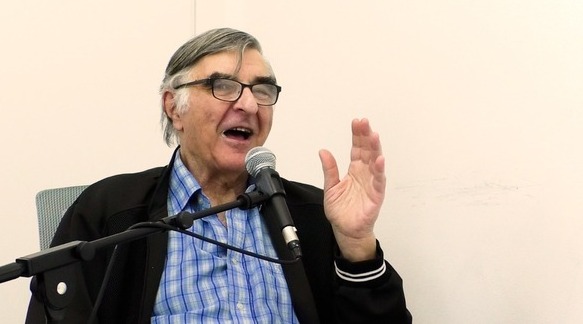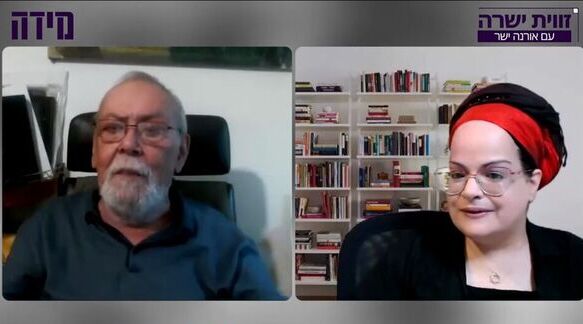MK Elazar Stern's solution to the Israeli conversion crisis creates more problems than it solves.
Recently, MK Elazar Stern proposed a major legislative overhaul of state conversion policy, an overhaul which is widely praised by many liberal religious and secular bodies · But a close look at the bill shows that it creates more serious problems than those it solves · Moreover, the claim that halachically non-Jewish Israelis will greatly increase does not stand up to the most basic check of Israeli demographic realities · A lesson in proper church-state relations and basic arithmetic

I. Background
As is well-known, the Chief Rabbinate serves as the official arm of the State of Israel with regard to certain matters, particularly Jewish personal status (marriage, divorce, conversion) as well as kosher certification and administration of public mikva’ot (ritual baths). This state of affairs has been in place since the Ottoman era, and has long been recognized as problematic in the context of a democratic state. The present Israel governing coalition is one of very few that has made improving this situation an integral part of its legislative agenda, and consequently, several bills and laws designed to limit the Chief Rabbinate’s power and control are currently working their way through the Knesset.
Each of these bills must be evaluated on their own merits and problems, as each realm of entanglement between state power and Jewish law/religion presents its own conundrums and challenges. For example, ending the chief rabbinate’s exclusive control over divorce will be far more difficult than ending its monopoly over kosher certification services. These and other areas will perhaps be the subject of future essays; for now, we will focus on the bill that has garnered much attention recently: MK Elazar Stern’s Conversion Bill.
This bill attempts to address a situation that arose in the wake of the mass immigration of Russian Jewry to Israel since the early 1990s. Eligibility for Israeli citizenship under the Law of Return differs from the definition of a Jew under traditional Jewish law (halakha), and indeed their goals are different. The Law of Return is intentionally based on the racist criteria of the Nuremburg Laws, as though to state emphatically that anyone sufficiently Jewish to be persecuted for it is sufficiently Jewish to have a home in the State of Israel. The halakhic criteria for Jewishness, on the other hand, are religious and theological in nature, determinant of one’s status vis-à-vis the covenant between God and the Jewish people that lies at the center of the Jewish faith.
As a result of this gap, there are an estimated 330,000 Israeli citizens who immigrated or whose parents immigrated from the Former Soviet Union by virtue of their connection to the Jewish people, yet who are not considered Jewish from a halakhic perspective. In the eyes of Israeli law, they are viewed as having “no religion” (in fact this group includes some 30,000 people from the FSU who profess to be Christian; there is general consensus, thankfully, that no attempt should be made to convert these Christians to Judaism).
The presence of this population generates two sets of problems. As stated succinctly by Rabbi Dr. Seth Farber, the head of ITIM, the organization that helped draft the law:
Practically, in Israel this means they cannot be married by the rabbinate or buried in the regular sections of Jewish cemeteries. In theory, it means that eight percent of the Jewish population of Israel is not Jewish, meaning that intermarriage rates will become rampant here in the coming years, and a situation will slowly develop that will threaten the Jewish character of the state.
Prior attempts to alleviate the issue have met with failure. As the explanation appended to the draft law states:
The absence of systematic legislation on this issue has generated various problems, from the heaping of unreasonable bureaucratic difficulties on prospective converts by means of refusal on the part of the Ministry of the Interior to recognize some of these conversions… to marriage registrars and rabbinical courts that refuse to recognize the conversions. The special conversion courts established by the government… do not satisfactorily address all of the prospective converts, and the legal ambiguity that surrounds the issue of conversion harms those who wish to convert. (p. 6)
That is, there have been prior attempts to create a conversion apparatus that would result in the conversion en masse of “people on no religion,” but those attempts did not achieve the results desired. According to statistics published by ITIM in May 2013, the number of converts from the FSU has declined every year since 2010. As noted by Prof. Yedidia Stern of the Israel Democracy Institute in May 2013, the number of conversions performed under the auspices of the state has declined by almost half between 2007 and 2011, despite the fact that the government set a goal in 2008 of doubling the annual number of converts.
As further stated in the draft bill’s explanation (pp. 6-7):
This proposal seeks to systematize the legal framework for conducting conversions by establishing a unit for supervising conversion, which will be responsible to systematize the issue of conversion in Israel, and which will be headed by a superintendent of conversion. It is further proposed that rabbis licensed to convert, who meet the qualifications defined in the bill, shall be able to convene special conversion courts and conduct conversions, while the superintendent will oversee that the conversions are being conducted properly, in accordance with the bill’s provisions. Thus, it will be possible to convene special conversion courts throughout Israel, subject to oversight and uniform standards.
It is also proposed that the status of those who convert be anchored in the law, such that it will not be possible to discriminate against them due to their conversions. Based on the principle that administrative failures must be resolved in order to help potential converts, this proposal precludes the voiding of conversions with the wave of a hand, grants authority to licensed rabbis to register converts for marriage, and enables the rabbinical court to systematize conversions conducted in independent courts.
At first glance, the proposed law seems eminently reasonable. It will certainly improve service and make the conversion process less bureaucratic. Perhaps the personal touch of a local rabbi can even transform the experience from a dry encounter with officialdom into a religiously meaningful experience. Moreover, the Chief Rabbinate will no longer be the central entity controlling conversion, but will be reduced to a regulatory body in charge of testing and licensing rabbis who wish to perform conversions.
Given the monopolistic power over matters of personal status held by the Chief Rabbinate thus far, granting individuals greater freedom of choice is a positive step in the direction of disentangling the fraught relationship between religion and state in Israel. Finally, there is every reason to hope that the increased availability of conversion courts, especially under the auspices of rabbis who take a more lenient approach to conversion than the present courts, will increase the number of conversions and help eliminate the disenfranchisement of “people with no religion” and the specter of assimilation and intermarriage.
Yet a closer look at the law will show that it is in fact deeply flawed on multiple levels. Rather than disentangling religion and state, it in fact further enmeshes them; it perpetuates an unhealthy and problematic paradigm that conflates Israeliness with Jewishness and thus treats non-Jews of any stripe as second class citizens; and it is based on such erroneous interpretations of the underlying demographic data that one can only conclude that the rabbis, professors, and politicians clamoring for this law are biased by preconceived notions, are deliberately pulling the wool over the eyes of the public in order to advance a particular vision, or are simply bad at high-school math. Each of these contentions will be addressed independently below.
II. Compromising Freedom of Religion
To understand how the present draft bill further enmeshes the state in religious affairs and effectively compromises rabbinic autonomy and the halakhic process, it is necessary to understand some of the halakhic background as well as some key points about the purpose of separation religion and state.
Until relatively recently in historical terms, becoming part of the Jewish people implied accepting its religion, and accepting the Jewish religion implied becoming part of the Jewish people. To paraphrase the biblical Ruth (1:16), there was no way to split “your people is my people” from “your God is my God.” However, European emancipation brought about the decoupling of Jewishness as a religious identity and an ethnic-national identity, and today becoming Jewish does not imply the adoption of any sort of religion. This specifically modern situation raised a question about the process of religious conversion. Rabbi Yitzhak Isaac Herzog formulates the problem thus:
Know that even though the law going back to the tannaitic era [that is, the first centuries CE – EF] was that ex post facto they are all [valid] converts, I have a serious concern nowadays. Earlier in Jewish history, a transgressor would be persecuted and held in contempt by his own people, and thus when a gentile accepted Judaism, even if he was primarily motivated by marriage, he knew that his standing within Jewish society would be very low if he did not observe the Torah. That is not the case today, when there are so many non-observant people who not only have no difficulty as a result, but even stand at the head of the nation and its communities. Therefore, we should be concerned that there is no real commitment to observe the commandments. Rather, out of ulterior motives, he makes a declaration with his mouth, but his heart is not in it… Therefore, today there is a particular responsibility on every rabbi to consider each case until he is convinced that it is reasonable that these people will really observe our holy religion. (Heikhal Yitzhak 1:21:c)
That is, the uncoupling of religious and national identity called into question the status of one who converted out of a desire to join the Jewish people but not observe the Jewish religion (that is, from the perspective of Orthodox rabbis, to become observant Orthodox Jews). Three main approaches to this issue emerged:
(a) Commitment to Jewish observance is not a sine qua non to conversion, either because there is no such requirement or because it is sufficient to “accept” that this is Judaism without really intending to observe it.
(b) It is prohibited to perform a conversion when it is clear that there is no real commitment to an Orthodox lifestyle; however, a conversion performed by a qualified court in which it became clear that there was no real commitment to observance is nevertheless accepted ex post facto.
(c) A conversion in which there was no sincere commitment to an Orthodox lifestyle is simply null and void.
The present situation maps itself onto these three approaches in approximately the following manner. Most Religious-Zionist rabbis, and especially their acknowledged halakhic authorities, accept approach (b). In practice, this was also the approach of Rabbi Ovadia Yosef. Some mainly Ultra-Orthodox Ashkenazic municipal rabbis and religious court judges have adopted approach (c) and have consequently refused to register the marriages or otherwise “annulled” the conversions of those who, by their lights, never adopted an Orthodox lifestyle. A small minority of rabbis adopt approach (a), none of whom are presently empowered by the state to perform conversions.
In practice, the Chief Rabbinate and the present conversion courts mainly adopt position (b). Converts are required to commit to an Orthodox lifestyle, though often with a knowing wink. Most converts do not, in fact, adopt an Orthodox lifestyle. The Chief Rabbinate has also implemented workarounds that allow such converts to bypass rabbis who would annul their conversions. Yet despite the laxity of conversion standards in the present court, few people are converting under their auspices. Some argue that it is the tiresome bureaucracy and the possibility of encountering an Ultra-Orthodox rabbi or official that deters potential converts at present. Others argue that both the rabbis and the potential converts are uncomfortable with a process that effectively encourages lying; a prospective convert who understands that conversion entails commitment to an Orthodox lifestyle, even if he or she knows that one can pay lip service without sincerely committing, will often prefer to opt out of the charade.
The state’s political echelons, however, has long clamored for approach (a). They want Orthodox rabbis to declare secular Israeli “people of no religion” just as Jewish as the secular Israeli Jews from whom they are increasingly indistinguishable culturally and socially. For much of secular Israel, observance of the cardinal commandments of living in Israel, speaking Hebrew, and serving in the military ought to render one sufficiently Jewish to be recognized as such by halakha. Unfortunately, all but a small handful of rabbis disagree.
Enter Elazar Stern’s conversion bill. By allowing municipal rabbis to convene conversion courts, Stern and his fellow travelers hope that approach (a) will now become not only a viable option but the vehicle for converting “people of no religion” en masse. The bill does not directly legislate a halakhic approach, but it does allow a heretofore marginal approach to take a major role and engineers a “race to the bottom” wherein conversion panels will compete with each other to make the conversion process as easy and devoid of commitment as possible.
Arguably, though, this move would be a positive step in the disentanglement of religion and state in Israel. After all, approaches (b) and (c) are currently privileged over (a), and once the law is passed the prospective convert will be able to choose the conversion court that he or she prefers. The vast majority of Orthodox rabbis may oppose the move, but from the citizens’ perspective there will be more freedom to choose between religious alternatives and less subjection to an alienating religious establishment.
When it comes to religious legislation, however, ascertaining whether a law enhances or limits freedom of religion has two dimensions, corresponding to the two basic religious freedoms that the government must protect: the extent to which the law protects the individual from religious authority (freedom from religion), and the extent to which the law protects religious institutions from state authority (freedom of religion). The Conversion Bill undoubtedly protects the individual from religious authorities, but in doing so it compromises the autonomy of religious institutions. The goal of religious legislation must be to reduce the coercive power of religious authorities without undermining their autonomy. Laws that protect individuals from religious authority by subjecting religious authority to state power do not enhance religious freedom. But the Conversion Bill does just that in clause 19:
19. A conversion certificate shall serve as proof of the Jewishness of the certificate’s bearer vis-à-vis any body and for the purposes of any matter, including the Rabbinical Courts Jurisdiction Law (Marriage and Divorce) 5713-1953.
In other words, in addition to allowing citizens to convert under the auspices of rabbis who adopt approach (a), it also demands that rabbis who adopt approaches (b) and (c) accept such conversions as a fait accompli, even if they deem such conversions to be invalid. This mandate is based on the Israeli Supreme Court’s determination that “the state recognizes the duty of rabbis who register marriages to recognize conversions performed under state auspices without any need for further examination of the Jewishness of those who come to register for marriage” (HCJ 2532/10, ITIM v. the Chief Rabbinate of Israel, cited in the ITIM report from May 2013). Had the law merely given every licensed rabbi the right to perform conversions as he sees fit as well as the right to refuse recognition of conversions he deems invalid, both primary objectives of religious freedom would be upheld. Requiring rabbis to accept the actions of other courts constitutes a blatant impingement of those rabbis’ freedom of religion and conscience.
Israel’s current political climate is quite sensitive to the protection of freedom from religion but has not even begun to internalize the importance of freedom of religion. Blunting the coercive power of the Chief Rabbinate is a worthy goal that should have been addressed long ago, but it must be accompanied by an increased tolerance of all forms of religious expression, even the kind deemed overly strict, once its coercive power has been removed. The freedom of one rabbi to perform conversions must be balanced by another rabbi’s freedom to reject the fist rabbi’s conversion. Unfortunately, this distinction is lost on Elazar Stern and his cohorts.
III. Jews, Israelis, and Second-Class Citizens
To Western eyes, the notion that a modern democratic state is directly involved in the process of religious conversion seems completely ludicrous. And yet, in Israel, conversion to Judaism is actively promoted by the government and sits atop the legislative agenda. One is tempted to believe that this is the result of pressure by religious parties, but that it not the case. The conversion agenda has been spearheaded consistently by majority secular parties: Yesh Atid and Livni’s Movement in the present Knesset, and Yisrael Beitenu in previous Knessets. Even the most avowedly secular, pork-and-shellfish eating atheist demands that a bunch of hats and beards validate that he is Jewish.
This is because in the Israeli mind, Jewish identity and Israeli identity are conflated. If one is not technically Jewish, according to this mindset, then one is not sufficiently Israeli. Non-Jewish Israelis, whatever the type, are thus regarded as second-class citizens, not quite Israeli. Moreover, when a conversion court rules that a prospective convert who speaks Hebrew, lives in Israel, fasts on Yom Kippur, and serves in the IDF is not sufficiently committed to Judaism, it is an affront to Israeli Jews who practices Judaism in much the same way. The demand that the rabbis recognize these Israelis of no religion as Jews is essentially a demand that the rabbis accept the religion of secular Israelis as a valid form of Judaism.
Although most Israelis are Jews and soon most Jews will be Israelis, and there is a good deal of overlap between Israeliness and Jewishness, being Jewish and being Israeli is not the same thing. If this were to be acknowledged, and if it would be possible to be fully Israeli without being Jewish, Israel would be in a much healthier place vis-à-vis all of its minority populations. The particular manifestations of the second-class status of people with no religion—particularly marriage and burial, as Farber writes—could be easily remedied through civil alternatives. Aliens could become citizens through a process of naturalization. The problem that the state created by bringing in a quarter million people of no religion would not require a remedy and would not need to be dumped at the rabbis’ doorsteps.
Yet instead of working toward a paradigm under which non-Jewish Israelis are full-fledged Israelis, the sponsors of the Conversion Bill instead perpetuate the old paradigm under which only a Jew is truly Israeli, but while sidestepping those rabbis with the gall to say that their version of Judaism does not pass muster.
The situation reminds one of Heinrich Heine, the German poet and essayist who, in 1825, converted from Judaism to Christianity. He later protested to his former coreligionists that he had in fact undergone “mere baptism, not conversion” and that he was motivated not by conviction, but by the fact that baptism is “the ticket of admission to European culture.” In an astounding historical irony, Heine has found his analogue in the modern State of Israel, where becoming a first-class citizen requires baptism in the mikveh.
IV. Bad Math
As noted, two central arguments are advanced for the need to convert people of no religion en masse: so that they can marry and be buried in Israel like anyone else, and to stem the growing tide of intermarriage and assimilation. These are the core arguments advanced by every proponent of a comprehensive conversion law. It is certainly unacceptable that so many Israelis have no way to get married in their home country, but the remedy is simple: institute a civil alternative. Burial may require a bit more creativity, but it too can be overcome.
That leaves assimilation and intermarriage, which indeed appears to be the central factor motivating the Conversion Bill. Individuals and groups who have publicly endorsed the bill speak of creeping assimilation and intermarriage in alarmist terms. For example, Beit Hillel, a somewhat liberal Orthodox rabbinic group, claims: “Objection to the Stern Law, which stems from a ‘stricter’ halachic position, may lead to a large breach of assimilation and much intermarriage.” Farber wrote: “To let the bill die now, or even to oppose the bill in its present form, will bring a new wave of assimilation, intermarriage, and may ultimately undermine the very nature of the Jewish state.”
Some of the rabbis who adopt approach (a) argue that even if a different approach would be preferable under other circumstances, the threat of assimilation and intermarriage warrants the adoption of a more lenient approach. It is an article of faith in certain circles that the 300,000+ Israelis of no religion are a ticking demographic time bomb – unless they are converted, they pose a risk to the Jewishness of the Jewish state.
The problem with this entire line of reasoning is quite simple: there is no threat of assimilation, and the specter of intermarriage is too small to warrant state involvement. This is borne out by data readily available from Israel’s Central Bureau of Statistics, from Knesset reports, and even from ITIM’s publications. Yet even without all of that, it is borne out by common sense.
Outside of Israel, assimilation and intermarriage are major threats. A minority of 2% or less must actively preserve its identity or else it will simply be absorbed into the host culture within a few generations. In Israel, the Jews are the host culture. People of no religion constitute 5% of the overall Jewish population. Majorities of over 90% do not assimilate into such small minorities. On the contrary, it is the minority that is assimilating into the majority as Israelis of no religion integrate into Israeli society. Elazar Stern’s fear that a 95% majority may assimilate into a 5% minority smacks of a “galuti” (exilic) mindset, a habit of thought formed during the long centuries of living as a minority in exile.
Furthermore, even if it could be argued that such a small minority indeed causes assimilation, it is unclear how a strictly formal, no-strings-attached conversion halts that process. So even when ITIM, Stern, and fellow travelers talk about “assimilation and intermarriage,” they really mean only intermarriage. Unless they are converted, the thinking goes, Israelis of no religion will become an increasing proportion of the population.
Except that they won’t. In fact, they will constitute an ever-diminishing percentage of the population.
To demonstrate that they will not grow as a proportion of the overall population, imagine that a group of 40 Israelis wash ashore on a desert island. The population is divided evenly between men and women. One of the men and one of the women are not Jewish, and the rest are. That is, 5% of the population is not Jewish. The couples pair off and have children. Among the second generation, we would expect 95% to be Jewish and 5% to be not Jewish, because according to halakha, Jewishness is determined by the mother. All children of the 19 Jewish women on the island are Jewish, regardless of who the father is. The children of the non-Jewish woman are not Jewish.
The same dynamic applies to the overall Jewish-Israeli population. There is a problem of a 5-7% (maximum) intermarriage rate, but that rate cannot grow. In fact, the rate will decline, for several reasons. Firstly, although all Israelis tend to have relatively large families, religious Jews tend to have larger families and are the least likely to intermarry. Thus, the number of Israelis with no religion may grow in terms of raw numbers, but it will not grow as fast as the overall Jewish Israeli population. Secondly, Israelis from the FSU have a higher emigration rate than Israelis overall.
The third and most significant factor in the reduction of the intermarriage rate is actually conversion. Despite the hand-wringing about the low number of converts—only c. 2,000 from the FSU annually—a glance at the profile of these converts, published by ITIM, shows something surprising and significant. More than 75% of all converts were under the age of 30, and c. 78% of all converts are women. As explained above, it is only women of no religion who are capable, halakhically, of giving birth to a new generation of Israelis of no religion. And it is specifically women of or before child-bearing age who constitute the majority of converts annually. So even if the overall number of converts is relatively small, the group whose conversion is most urgent—fertile women—are actually converting in significant numbers. The men pose no threat to the Jewish future of Israel.
The most recent population figures published by the Central Bureau of Statistics support these assertions. Despite continued immigration from the FSU, the ratio of Israelis with no religion (including non-Arab Christians) to Israeli Jews has not changed in the 10 years worth of data represented in the graph. As immigration from the FSU continues to slow (c. 9,000 in 2012, the latest year for which there is data), the proportion will shrink, and eventually the raw numbers of “people with no religion” will shrink as well as the older generation dies out and is replaced, at least in part, by the children of the thousands of women who have converted.
Still, one might argue that even a miniscule rate of intermarriage is too high. The marriage of a technically non-Jewish man with a Jewish woman is terrible, one might argue, even though the children will be Jewish. For many, it is indeed tragic. If one of my own children were to marry a non-Jew, God forbid, I would consider it a tragedy. Nevertheless, the present and long-term risk of intermarriage is and will continue to be low enough that it does not warrant the attention of state policy. The state can afford to let people marry who they wish and let people convert if they wish without forcing the issue.
V. The Alternative: No State Involvement in Conversion At All
Fear of intermarriage and assimilation is baseless. The inability of Israelis of no religion to wed in Israel can be solved simply by instituting a civil option. That leaves only the problematic bureaucracy of the present conversion system. It is possible that the presence of a civil marriage option would actually improve service, as prospective converts would no longer be suspected of converting solely so that they could get married.
There is no need to take that chance, though. Once a civil option is instituted alongside the existing Chief Rabbinate track for marriage, the state can completely deregulate the conversion system. Rabbis and laymen from any denomination will be able to convene conversion panels at their whim, and the state will have no need or reason to authorize or reject any conversion. Individual rabbis, even official municipal rabbis, will have the autonomy to accept or reject conversions performed by another court. Converts who are turned away by one rabbi or court will have the option of going to another rabbi or simply marrying civilly and then having a religious ceremony of their choosing officiated by a rabbi of their choosing. The question of divorce is a separate and thornier question, but it can also be overcome and in any event need not prevent adopting changes when it comes to marriage.
This will enhance Israelis’ religious freedom without requiring any rabbi to go against his religious conscience. It will also ensure that Israelis of no religion need not undergo religious conversion in order to become first-class citizens of their state.
Elli Fischer is a writer, rabbi, and translator from Modiin. His work has appeared in many publications, including Commentary, Lilith, and the Lakewood Scoop. He can be followed on Facebook and twitter.
To receive updates on new articles in English, join Mida on Facebook or Twitter or join our mailing list.






"The Law of Return is intentionally based on the racist criteria of the
Nuremburg Laws, as though to state emphatically that anyone sufficiently
Jewish to be persecuted for it is sufficiently Jewish to have a home in
the State of Israel. The halakhic criteria for Jewishness, on the other
hand, are religious and theological in nature, determinant of one’s
status vis-à-vis the covenant between God and the Jewish people that
lies at the center of the Jewish faith."
How can you say that? The only difference between between the two definitions of Jewishness is how much Jewish DNA you need to have. In other words, they're both racist, the halachik definition arguably more so.
How can the halachic definition be "more racist" if a convert is considered a full Jew regardless of ancestry?I have personally met converts that were full-blooded Japanese, Han Chinese, African American, Finnish… In fact, the grandson of a top Nazi leader converted to Judaism and became an Orthodox rabbi, thus fulfilling the rabbinical prophecy that "the children of Amalek will one day teach Torah in Bnei Brak"
Hi Elli, you have a lot of good points here, especially about the practical aspects of the topic, but I really object to two premises of your article. First, I think you attribute motives to people without evidence. Second I think you omit to deal with the best argument of the Farber/Stav/Stern school until the very end, namely that the Rabbanut and the Rabbinate are not passive observers in this process ("an umpire calling balls and strikes") but more like a teacher or a parent with some interest in and responsibility for the outcomes of the participants. I think this second criterion makes a big difference because If you look at it that way, then not only do you have to be concerned for the best ideal framework , but you also have to worry about the efficacy of your proposal, and it may be worth giving up a lot of idealism in favor some efficacy. Moreover, the loss of anything on the efficacy scale isn't "free" either, but has to be considered as a real cost. All in all, that may be best argument I can make for continuing the Rabbanut system, and even if I'm not sure it's persuasive, it's a position I can appreciate and I think you can too. Thanks!